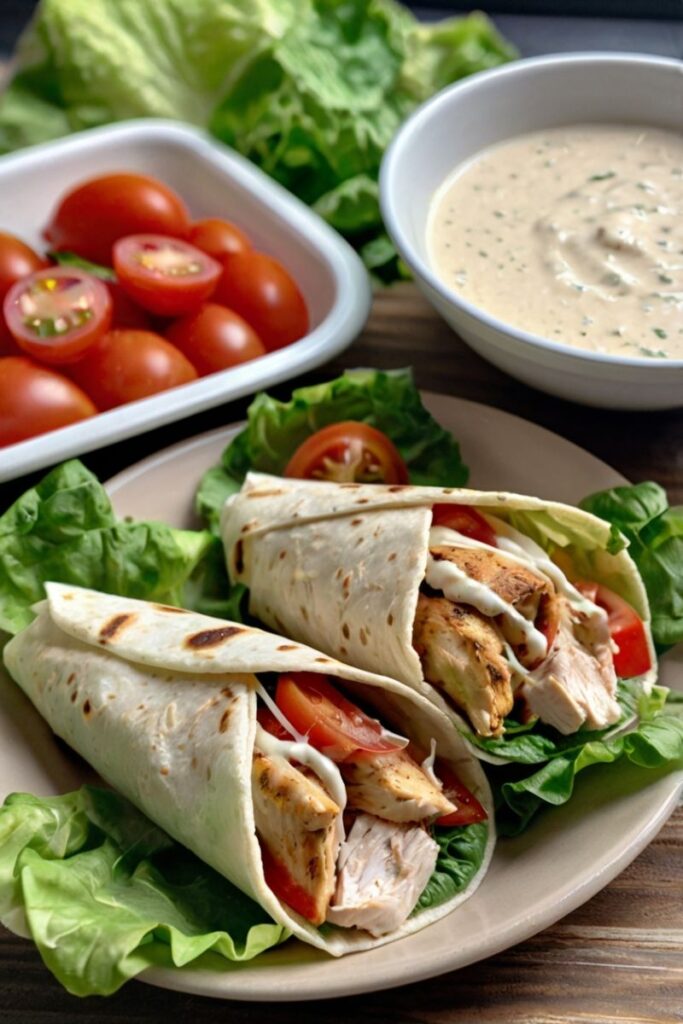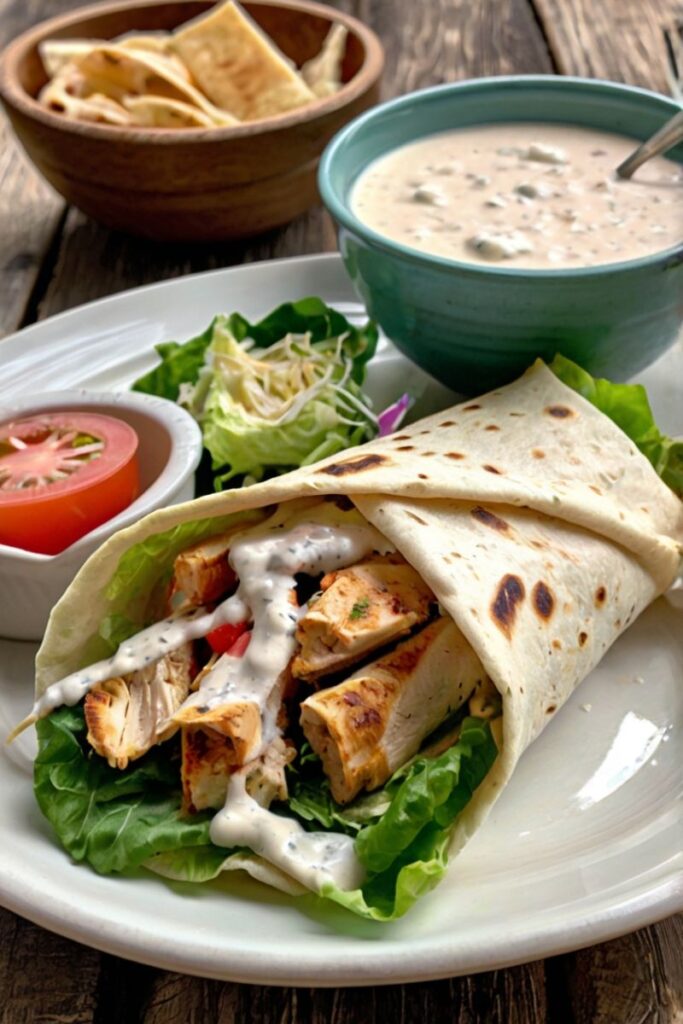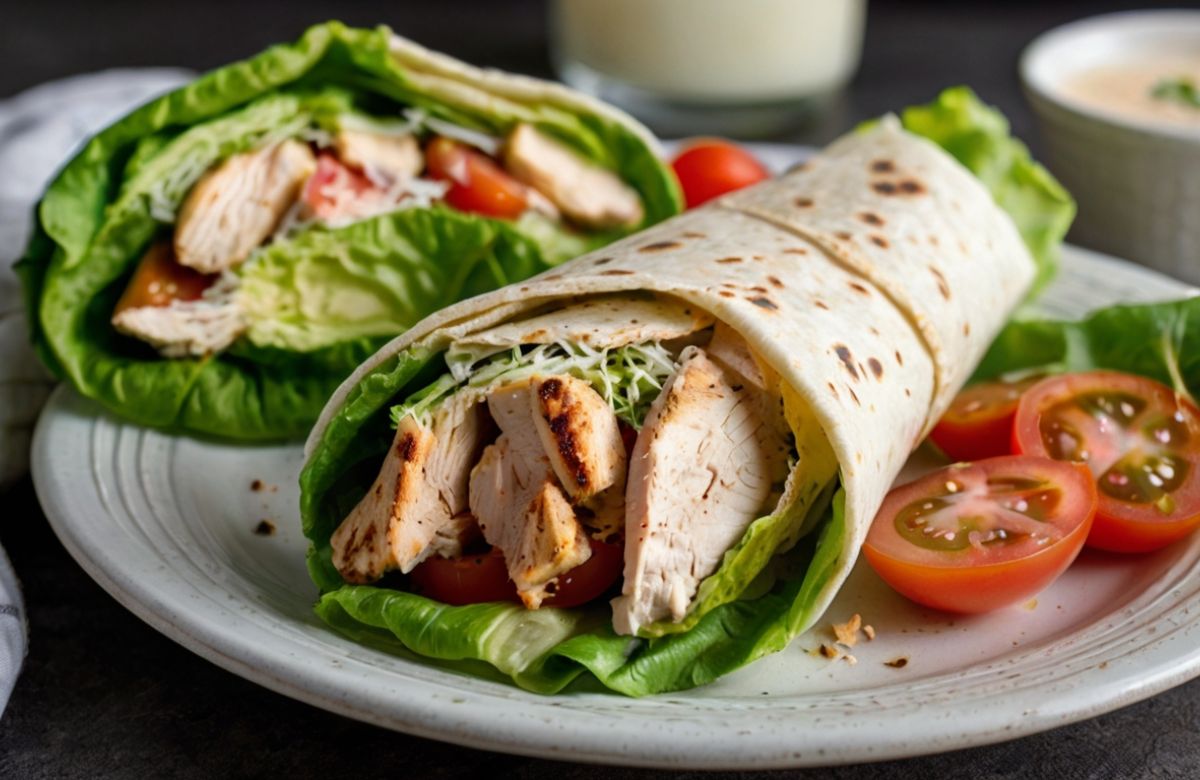Ever crave something quick, fresh, and full of flavor?” That’s exactly what Chicken Caesar Wraps deliver every single time. I still remember the first time I made one. It was a rushed afternoon. I had leftover grilled chicken, half a head of romaine, and a bottle of Caesar dressing. I wrapped them up in a tortilla, added a sprinkle of parmesan, and took a bite. Instant satisfaction. It was crisp, creamy, savory, and light everything I didn’t know I needed in that moment.
Chicken Caesar Wraps take the classic Caesar salad we all know and love and give it a handheld twist. The result? A satisfying, portable meal that works for lunch, dinner, or even on the go. The combination of warm, juicy chicken with cool, crunchy lettuce and rich dressing is hard to beat. Add a soft flour tortilla to wrap it all together, and you’ve got a meal that hits every note texture, flavor, and convenience.
In this post, I’ll guide you through each step. You’ll learn how to season and cook the chicken for maximum flavor. I’ll show you how to build a wrap that doesn’t fall apart. We’ll talk about dressing balance, tortilla choices, and even meal prep tips. This is more than just a wrap, it’s your new favorite quick fix. Simple ingredients. Big results. Stick around and learn how to master the Chicken Caesar Wrap from your own kitchen.
Chicken Caesar Wraps and Their Culinary Heritage
The Caesar Salad itself has a fascinating origin story, created not in Italy as many assume, but in Tijuana, Mexico, by Italian American restaurateur Caesar Cardini in 1924. The wrap format emerged decades later during America’s health conscious revolution of the 1980s and 90s, when tortillas became popular alternatives to bread.
What makes these wraps special is their perfect balance of textures and flavors. The warm, juicy chicken against cool, crisp lettuce. The creamy dressing contrasting with crunchy croutons. The nutty Parmesan adding depth while the subtle tang of lemon brightens everything up. It’s a symphony of complementary elements working in perfect harmony.
The best Chicken Caesar Wraps honor the integrity of the original salad while embracing the convenience and portability of the wrap format. Let’s break down how to craft the perfect version in your own kitchen.
1. Ingredients & Substitutions
For the Chicken:
- 2 boneless, skinless chicken breasts (about 1 pound)
- 2 tablespoons olive oil
- 1 teaspoon garlic powder
- 1 teaspoon dried oregano
- ½ teaspoon smoked paprika
- Salt and freshly ground black pepper
For the Caesar Dressing:
- ½ cup good quality mayonnaise
- 2 tablespoons fresh lemon juice
- 1½ teaspoons Dijon mustard
- 2 anchovy fillets, minced (or 1 teaspoon anchovy paste)
- 2 garlic cloves, finely minced
- ⅓ cup freshly grated Parmesan cheese
- ¼ teaspoon Worcestershire sauce
- Salt and freshly ground black pepper to taste
For Assembly:
- 4 large flour tortillas (10-12 inch diameter)
- 2 hearts of romaine lettuce, washed, dried, and chopped
- ½ cup Parmesan cheese shavings
- 1 cup croutons (preferably homemade)
- Lemon wedges for serving
The quality of your ingredients will dramatically impact the final result. For chicken, free range organic makes a noticeable difference in flavor and texture. When it comes to Parmesan, splurge on authentic Parmigiano Reggiano and grate it yourself. Pre grated varieties contain anti caking agents that affect both flavor and meltability.
For those with dietary restrictions, several substitutions work beautifully. Grilled portobello mushrooms or crispy tofu make excellent vegetarian protein alternatives. Greek yogurt can replace mayonnaise for a lighter dressing with extra protein. Gluten free tortillas or large lettuce leaves can substitute for standard flour tortillas.
Anchovy averse cooks can use capers or olives to provide that crucial briny, umami quality. While purists might object, a touch of miso paste can offer a similar depth. However, I’d argue that anchovy is worth embracing it doesn’t make the dressing fishy, just intensely savory.
2. Step by Step Instructions

Preparing the Chicken:
- Pound chicken breasts to an even thickness of about ½ inch. This ensures quick, even cooking and tender meat. Place chicken between plastic wrap and use a meat mallet or heavy skillet.
- Season chicken with olive oil, garlic powder, oregano, smoked paprika, salt, and pepper. Let it marinate for at least 15 minutes (or up to 4 hours in the refrigerator for deeper flavor penetration).
- Heat a grill pan or skillet over medium high heat. Cook chicken for 4-5 minutes per side until internal temperature reaches 165°F (74°C). Many home cooks overcook chicken out of safety concerns—invest in a meat thermometer to achieve perfectly juicy results.
- Remove chicken from heat and let rest for 5-10 minutes before slicing. This critical resting phase allows juices to redistribute throughout the meat. Slice against the grain into thin strips for maximum tenderness.
Making the Caesar Dressing:
- In a medium bowl, whisk together mayonnaise, lemon juice, Dijon mustard, minced anchovies, and garlic until smooth. The most common mistake here is rushing—take your time to properly emulsify these ingredients.
- Stir in grated Parmesan cheese and Worcestershire sauce. Season with salt and pepper to taste, remembering that both the cheese and anchovies contribute saltiness.
- If dressing seems too thick, thin with a teaspoon of water at a time until desired consistency is reached. For maximum flavor development, refrigerate dressing for at least 30 minutes before using.
Assembly:
- Warm tortillas slightly to increase flexibility and prevent cracking. You can do this by placing them briefly on a hot skillet, microwaving for 10-15 seconds, or wrapping in foil and heating in a 300°F oven for 5 minutes.
- Lay tortillas flat on a clean work surface. Spread about 2 tablespoons of Caesar dressing over each tortilla, leaving a 1 inch border around the edges.
- Arrange romaine lettuce down the center of each tortilla. Top with sliced chicken, Parmesan shavings, and croutons. Many people distribute ingredients evenly across the entire tortilla this is incorrect for proper rolling technique. Instead, create a concentrated line down the center.
- To roll the wrap, fold in the sides first, then roll from the bottom up, tucking in the edges as you go. The key is to roll tightly without tearing the tortilla. For neater presentation, secure with toothpicks or wrap in parchment paper.
- For optimal texture, serve immediately. If preparing ahead, wait to add croutons until just before serving to prevent sogginess.
3. Cooking Techniques & Science
The success of a Chicken Caesar Wrap hinges on understanding a few key culinary principles. First, the chicken preparation: pounding creates even thickness and breaks down muscle fibers, resulting in more tender meat. The brief marination period allows salt to penetrate the meat through osmosis, seasoning it throughout while the acid in lemon juice begins gently denaturing proteins.
During cooking, the Maillard reaction creates hundreds of new flavor compounds on the chicken’s surface. This non enzymatic browning occurs when amino acids and reducing sugars react under heat, creating that irresistible savory quality and appetizing golden brown color. Letting the chicken rest after cooking prevents moisture loss, while cutting immediately allows juices to escape, resulting in drier meat.
The dressing science is equally fascinating. Traditional Caesar dressing is an emulsion a temporary suspension of two immiscible liquids (oil and water/lemon juice). Using mayonnaise as a base provides lecithin from egg yolks, a powerful emulsifier that maintains stability. The anchovies contribute glutamates, responsible for umami flavor, while the lemon’s acidity brightens flavors and balances richness.
The textural contrast in Caesar wraps isn’t just pleasing, it stimulates more of our sensory receptors, creating a more engaging eating experience. The crunch of romaine activates different mechanoreceptors than the chewy tortilla or tender chicken, making each bite more satisfying.
For crouton perfection, understanding starch retrogradation helps. Slightly stale bread makes superior croutons because some moisture has evaporated and starch molecules have realigned, creating a structure that crisps beautifully when toasted. Fresh bread contains too much moisture, resulting in soggy centers.
4. Serving & Pairing Suggestions
The presentation of Chicken Caesar Wraps can range from casual to elegant. For everyday meals, wrap in parchment paper and tie with kitchen twine for a practical, portable lunch. For more formal presentations, slice wraps diagonally into pinwheels and arrange on a serving platter with fresh lemon wedges and additional dressing for dipping.
Temperature contrast enhances enjoyment. Slightly warm chicken against cool, crisp lettuce creates a more dynamic eating experience. Consider warming the assembled wrap briefly in a panini press for a different texture profile and flavor release.
Chicken Caesar Wraps pair beautifully with several complementary sides. A light tomato soup provides acidic contrast to the creamy dressing. Sweet potato fries offer color contrast and textural variety. For beverages, crisp white wines like Pinot Grigio or Sauvignon Blanc complement the lemony dressing, while sparkling water with lemon refreshes the palate between bites.
For a complete menu, consider Mediterranean inspired accompaniments. Marinated olives, a simple cucumber salad, or grilled vegetables maintain the fresh, bright flavor profile while adding variety. To elevate the wrap itself, consider adding avocado slices, sun dried tomatoes, or crispy prosciutto for interesting flavor variations.
Chicken Caesar Wraps as Meal Prep

These wraps excel as make ahead meals with proper technique. Prepare components separately and assemble just before eating. Store cooked chicken and dressing in separate airtight containers. For maximum freshness, wash and thoroughly dry lettuce before storage excess moisture accelerates spoilage.
The advanced meal prepper might consider vacuum sealing portioned chicken to preserve juiciness. Dressing can be stored in small mason jars or silicone storage bags. Pre cut vegetables stored with a paper towel to absorb excess moisture will maintain crispness longer.
When assembling ahead, employ strategic layering dressing should never directly contact the tortilla as this causes sogginess. Instead, create a lettuce barrier between dressing and tortilla. If croutons are a must have, pack separately in a small container to add just before eating.
Final Thoughts: Chicken Caesar Wraps
The humble Chicken Caesar Wrap demonstrates how culinary classics can evolve without losing their essential character. By understanding the principles behind each component perfectly cooked chicken, balanced dressing, and strategic assembly, you transform a simple lunch option into a showcase of culinary expertise.
What makes these wraps extraordinary isn’t complex technique or exotic ingredients, but careful attention to detail and respect for balance. The best versions honor tradition while embracing innovation, maintaining the Caesar salad’s signature flavor profile while improving portability and customization.
Whether you’re preparing a quick lunch, elegant appetizers, or meal prepping for the week, mastering Chicken Caesar Wraps adds a versatile, crowd pleasing option to your culinary repertoire. Remember that perfection lies in quality ingredients, proper technique, and thoughtful assembly elevating this seemingly simple dish to something truly memorable.
FAQs
How can I make a healthier version of Chicken Caesar Wrap?
Substitute Greek yogurt for mayonnaise in the dressing, use a whole grain tortilla, and increase the vegetable content by adding spinach or kale alongside romaine. Grilled chicken breast is already a lean protein choice.
Can I prepare Chicken Caesar Wraps in advance?
Yes, but store components separately and assemble just before eating. If pre assembling, create a moisture barrier between wet ingredients and the tortilla using a layer of lettuce, and add croutons just before serving.
What’s the best way to prevent wraps from getting soggy?
Pat all ingredients dry before assembly, particularly lettuce. Place a barrier of lettuce between the tortilla and wetter ingredients like dressing or chicken. When making ahead, consider storing dressing separately in a small container.
Can I make these wraps without anchovies?
Absolutely. While anchovies provide traditional umami depth, substitutes include capers, olives, miso paste, or Worcestershire sauce (use a bit extra). The flavor profile will be slightly different but still delicious.
What’s the key to perfectly moist chicken for Caesar wraps?
Pound chicken to even thickness before cooking, use a meat thermometer to avoid overcooking (remove from heat at 165°F/74°C), and always let chicken rest 5-10 minutes before slicing to allow juices to redistribute.

Swiftly Captions by Tina Smith — Quick, flavorful food recipes made simple, bringing fresh inspiration to your kitchen every day






